Last Updated on April 16, 2023
A Chocolate Lab is the rarest color variation of the purebred Labrador Retriever and not a separate dog breed. It comes in all shades of brown, from light liver to dark mahogany.
Chocolate Labradors are medium-to-large-size dogs that measure 21.5 to 24.5 inches (55 to 62 cm) tall and weigh between 55 and 80 pounds (25 to 36 kg). The average lifespan of the Chocolate Lab is around 10 to 12 years.
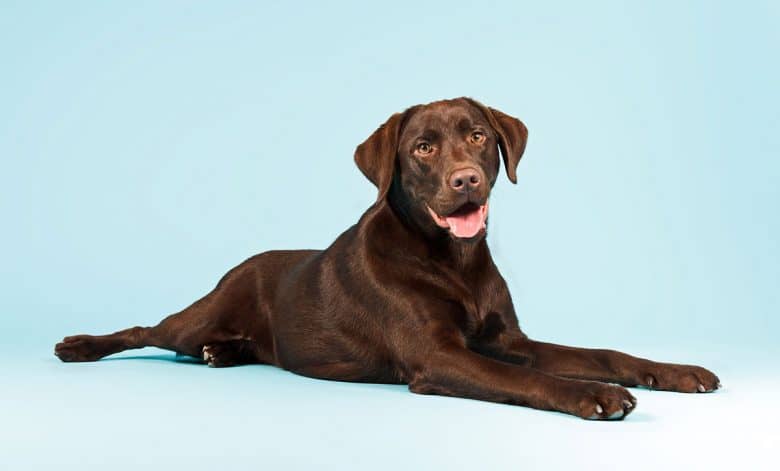
Purebred Labradors, including Chocolate Labs, are excellent family pets. They are friendly, affectionate, and gentle dogs, especially for young children. Due to their rarity, buying a Chocolate Labrador Retriever puppy comes at a higher price than Yellow and Black Labs. You can get them between $800 to $2,250 from a reputable breeder.
We will discuss everything you need to know about the Chocolate Labrador breed. From its history, temperament, diet, exercise, and grooming needs, to its common health issues. Read our complete guide and see if this intelligent and outgoing dog is suitable for you!
Quick Navigation
- 1 The Chocolate Labrador at a Glance
- 2 Where Did the Chocolate Labradors Originate?
- 3 What Does a Chocolate Labrador Retriever Look Like?
- 4 How Big Will a Chocolate Lab Get?
- 5 Are Chocolate Labradors Harder to Train?
- 6 How to Take Care of Your Chocolate Labrador Retriever
- 7 Chocolate Labrador Health Issues
- 8 How Much are Chocolate Lab Puppies?
- 9 Who Should Get a Chocolate Labrador Dog?
- 10 Reference
The Chocolate Labrador at a Glance
We’ve put together a table below to give you a quick overview of the Chocolate Labrador.
| Breed Summary | Chocolate Labrador Quick Facts |
| Group | Sporting Group |
| Breed Purpose | Hunting Dog |
| Breed Size | Medium-to-Large |
| Height | 21.5 to 24.5 inches (55 to 62 cm) |
| Weight | 55 to 80 lbs (25 to 36 kg) |
| Coat Type | Short, straight, dense double coat |
| Shedding | Heavy |
| Lifespan | 10 to 12 years |
| Temperament | Gentle, Intelligent, Even-Tempered |
| Energy | High |
| Exercise Needs | 1 hr per day |
| Average Price | $800 to $2,250 |
Where Did the Chocolate Labradors Originate?
Chocolate Labs might be well known in the show-ring today, but back when the breed was gaining recognition, they were all mostly Black Labs.
Yellow Labradors, along with their Chocolate or Liver brothers, were simply culled at birth. This is rather unfortunate as litters could have all three colors present. This is due to the way color genetics work.

To get a brown puppy, you need two recessive genes present and these recessive genes can be hidden in a Black Labs.
When two Black Labs with the recessive gene have a litter together, chances are there will be Chocolate Labrador puppies.
Since the brown comes from the hidden gene, the color survived in spite of all the attempts at breeding it out of the Labrador pedigree.
The color was finally recognized by kennel clubs in the twentieth century, but it wasn’t until the 1960s did these brown-colored water dogs become popular.
Black Labradors have remained the most popular choice for the field, most probably due to the history of these dogs.
They originated from Newfoundland and were bred from St. John’s water dogs or the lesser Newfoundlands, which were mainly black.
Impressed with the dog’s trainability and talent on the field, breeders tried to maintain the St. John’s water dogs’ temperament as well as coat color.
What Does a Chocolate Labrador Retriever Look Like?
It’s funny but Labrador Retriever puppies are born with blue eyes. Over time, their eyes will darken into brown. This usually happens between the 12 – 16 week mark.
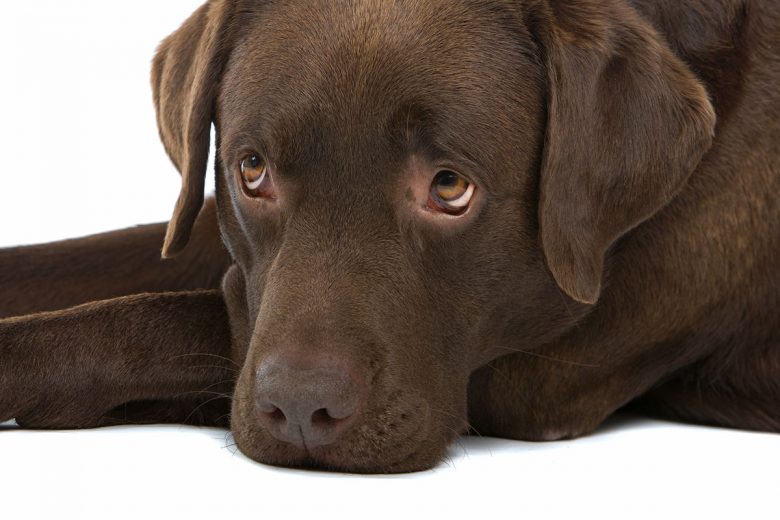
All Labs should have brown eyes. Chocolate Labs can sometimes have hazel-colored eyes. If your adult Labrador has blue eyes, chances are, it’s not a purebred Labrador.
They should have a proportionate outline, not overly low to the ground nor lanky and they have a pronounced neck that enhances their retrieving.
Bearing in mind that these are gundogs bred to work in harsh conditions and long hours, the breed standard from the American Kennel Club states that Labradors should be athletic but not overly stocky.
While it is not rare for a Labrador to have white on their chest, they can only be solid-colored in order to be permitted in the show ring.
While show dogs are often heavier, they shouldn’t be chunky. Their muzzles and heads should be well defined.
English Chocolate Labs VS. American Chocolate Labs
Most Chocolate Labradors are English Labs, because English basically means show dogs and American Labs are field dogs.
It’s unclear how this nickname came about, but it could be because showing dogs is much more common in the UK, whereas Labs were largely used as hunting companions in the U.S.
If you put the two together, you’ll see subtle differences in their size and build. Show dogs are bred for conformation and will match the AKC’s breed standard a lot closer than a field dog.
Concessions are often made for field dogs as they are much more focused on skill and stamina. Some can be up to 2 inches (5 cm) taller than the tallest English Lab.
American Labs usually have less defined features, such as the stop between the skull and muzzle. For more information on how to differentiate the two, we have a comparison chart that you can check out.
Read more: English Lab vs American Lab
How Big Will a Chocolate Lab Get?
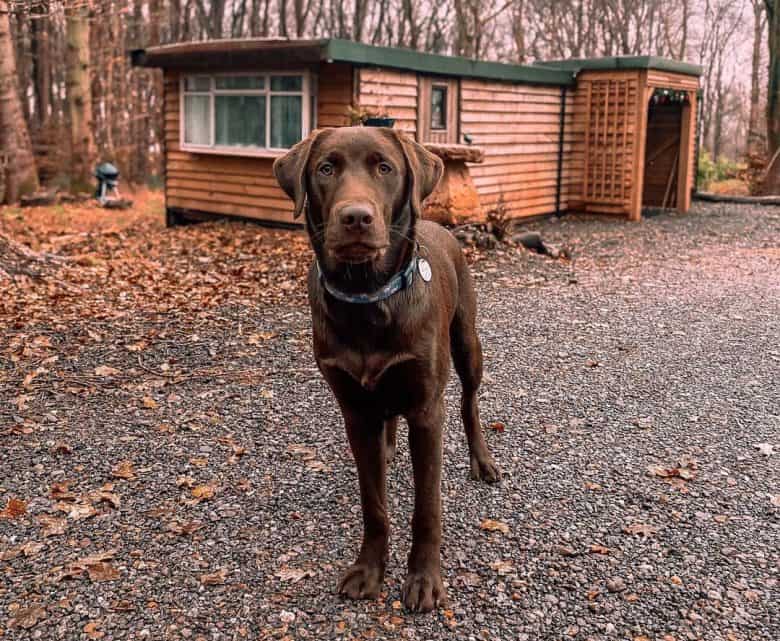
The Chocolate Labrador classifies as a medium-to-large-sized dog. A female Chocolate Lab can grow around 21.5 to 23.5 inches (55 to 60 cm) and can weigh between 55 to 70 pounds (25 to 32 kg).
The male Chocolate Labrador Retriever can grow taller at 22.5 to 24.5 inches (57 to 62 cm) and heavier at 65 to 80 pounds (29 to 36 kg) than the female counterpart.
Chocolate Labradors are considered full-grown when they reach their adult height anywhere between 6 to 12 months of age.
| Chocolate Labrador Physical Features |
Male | Female |
| Height | 22.5 to 24.5 inches (57 to 62 cm) |
21.5 to 23.5 inches (55 to 57 cm) |
| Weight | 65 to 80 lbs (29 to 36 kg) |
55 to 70 lbs (25 to 32 kg) |
![]() Related Read: When Do Labs Stop Growing?
Related Read: When Do Labs Stop Growing?
Coat & Color: Why is my Chocolate Lab so dark?
These beautifully brown dogs can be almost any hue, from a diluted brown also known as Silver Lab, to a deep mocha color.
As previously mentioned, this chocolate color has been hidden away in the bloodline of Labradors because it’s caused by a recessive gene.
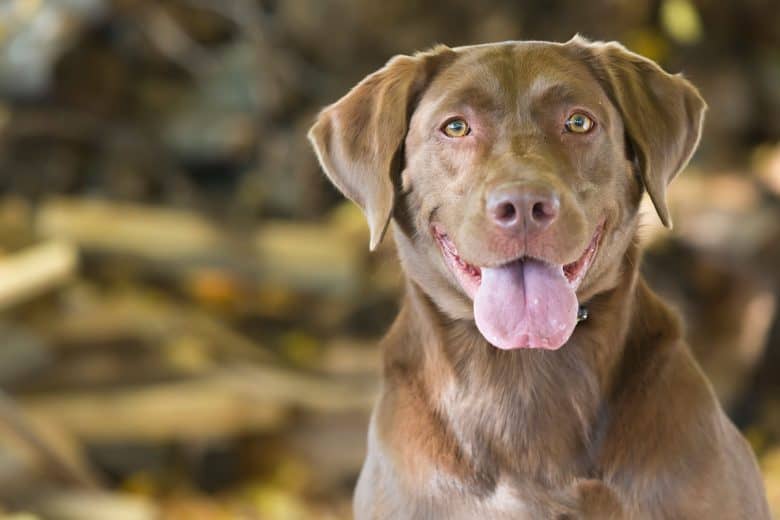
This makes their chocolate coat quite special. They would have been rare in nature, but with genetic testing and specialized breeders, you’ll find that Chocolate Labs are abundant.
If you find color genetics fascinating, you might want to give our Labrador Retriever colors post a read. It talks about all the different shades of Labradors and how color is inherited.
Their chocolate coats have a glossy and waterproof outer fur, and a dense and well-insulated undercoat. This means that they are not hypoallergenic and will shed copiously in spring and autumn.
Are Chocolate Labradors Harder to Train?

Black dogs have always suffered prejudice due to superstition or their portrayal in the media.
The different colors of Labradors also come with their own stereotypes and Chocolate Labs have been labeled as hyperactive.
While the logical explanation could be that since chocolate dogs are rarer, there’s a much smaller gene pool, and not many options to choose from.
Therefore, if there was a popular brown sire that carried the predisposition for over-activeness, his pups would likely inherit it and they will pass it on as well.
It’s more about breeding than color, and there have been no studies to prove that color affects temperament or intelligence.
Labradors are all amazing family dogs, gentle with kids and other animals. The English variety would most likely make a better house pet, as Americans can be a tad high-strung.
Aside from that, a well-trained Labrador should not be aggressive, nor should it bark excessively.
This breed is relatively easy to train and are often suggested for first time owners. They are smart and make wonderful assistance dogs, rescue dogs, and hunting companions.
Many mistakes their size for a dog that needs to be in a landed property, but all they want is to curl up at their owner’s feet at the end of a long, hard day.
If you can meet their daily exercise needs, they are actually excellent apartment dogs.
How to Take Care of Your Chocolate Labrador Retriever
Labrador puppies can be exuberant, just check out Freddy’s daily routine! He is just a ball of fluffy energy:
As with any dog, caring for them includes giving them the stimulation and attention they require, aside from providing food, water, and shelter.
Like Black Labs, brown Labradors also tend to overheat quicker due to their dark coats.
It’s science! If it’s hot out, or more than 90 degrees Fahrenheit (32 Celsius), make sure they have shade and lots of water to help them stay safe. Heat strokes can be fatal.
In winter, they can stay quite warm due to their double coats. They were bred for Canadian winters, after all.
As a matter of fact, they used to plunge into freezing cold waters to help their fishermen friends to haul their nets in. Safe to say, that can take care of themselves.
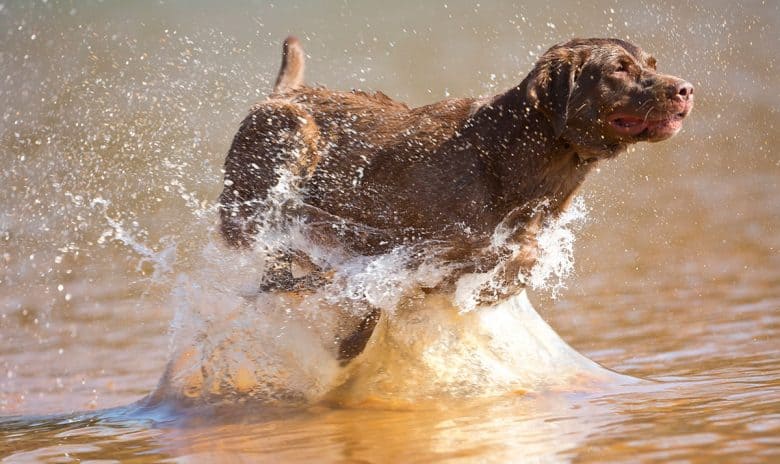
However, they aren’t arctic dogs like the Malamute or Husky, so if it’s lower than 20 degrees Fahrenheit (-6 Celsius), you might need to give them some assistance. Keep them indoors or offer him shelter from the elements.
Exercising your Chocolate Labs
Labradors are a working breed, which means that their energy levels are slightly higher than say, a companion breed. Pekingese and Pugs are such examples.
Labradors are active pooches and will require at least an hour’s worth of exercise a day.
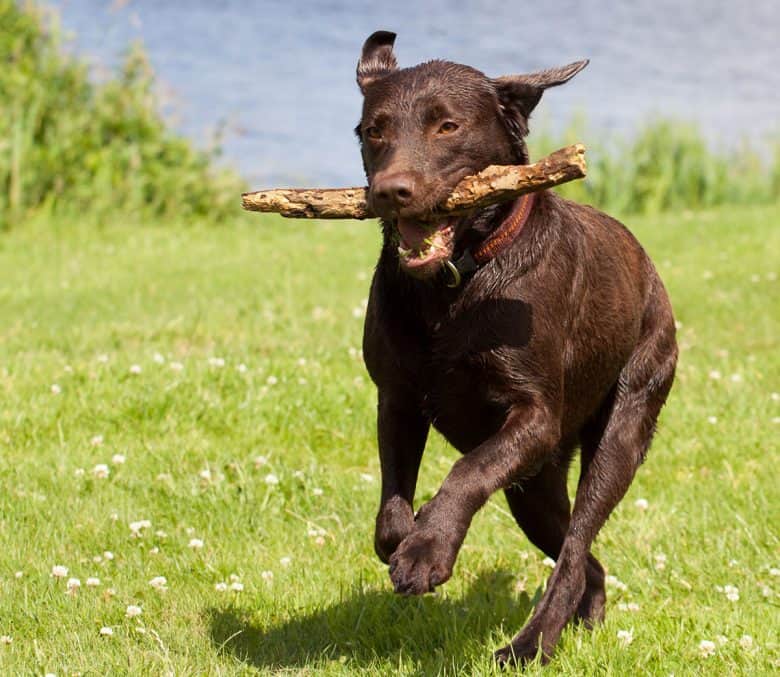
They could do with more, but you need to be careful not to overwork them. Labradors have known to overexert themselves to the point of collapse.
Furthermore, to prevent joint problems from developing, it’s best to avoid strenuous activities till they are two years old.
Before they are fully grown, you should exercise them based on their age. For instance, a 3-month-old puppy only needs approximately 15 minutes of exercise daily.
This means no trekking in the first year of your pup’s life, although he’ll love nothing more than to join you.
According to the kennel club in the UK, “a good rule of thumb is a ratio of five minutes exercise per month of age (up to twice a day) until the puppy is fully grown.”
When it comes to training, you’ll find that it’s rather effortless. These people-pleasing Labs are naturally keen to learn.
They respond best to gentle training and positive reinforcement. Consistency will ensure that your puppy grows up into an obedient buddy.
How do I make my Chocolate Lab’s coat shiny?
Labradors are extremely low maintenance and they don’t need haircuts to keep them looking good – unlike their long-haired cousins, the Golden Retriever.
All they need is a bath when they are stinky and a thorough brush every now and then.
Their water-repellent coat will keep it rather clean. Even if they get muddy, you can simply brush it off when it’s dried.
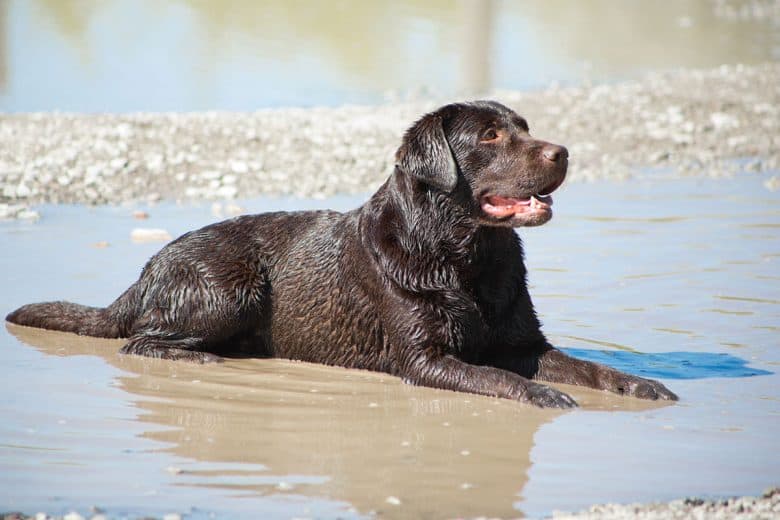
One good thing about brown dogs is that dirt doesn’t show up as easily as on yellow dogs. This doesn’t mean that you don’t need to bathe them, but you should try to shower them as infrequently as possible.
Showering them too often might cause certain problems. Dog shampoos can have a drying effect, which is why it’s best to hold it off until it’s really needed. If possible, once a month would suffice.
If hygiene matters a whole lot to you, you can use pet-friendly wet wipes to clean them in place of bathing them.
When choosing a soap, you want to make sure that it suits your dog. Some are fine with just about any brand, whereas others with more sensitive skin might require something more gentle.
What is the best dog food for Chocolate Labs?
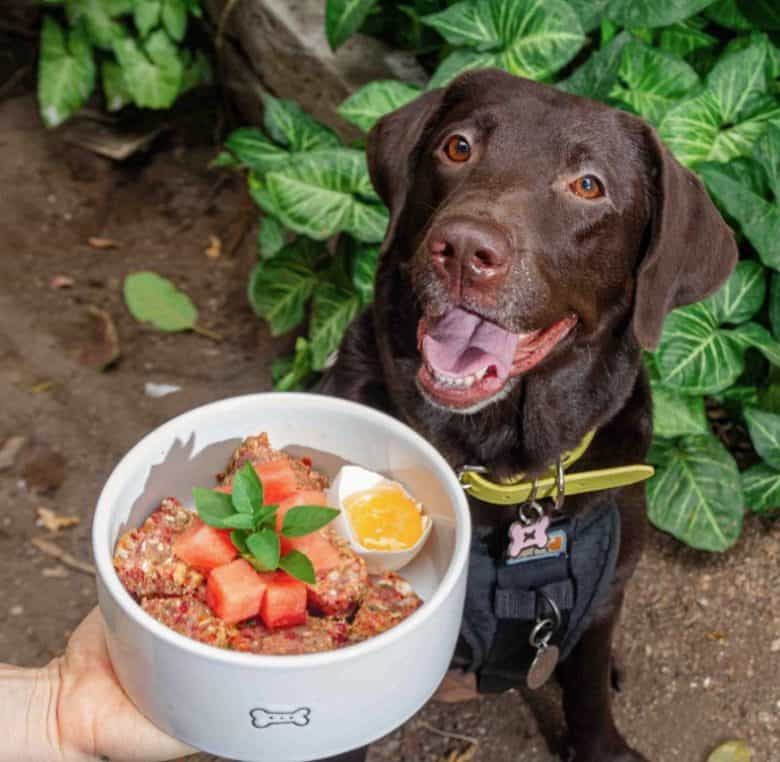
If you want the absolute best dog food for your pup, you can check out our guide here. We will walk you through how to feed your pup to ensure proper growth, and what dog food best suits your dog and his lifestyle.
On a whole, Labs eat anywhere between 2 – 5 cups of kibble a day. This should be good quality kibble, filled with good nutrients.
You generally want to stay away from fillers such as corn and go for fibrous fillers such as potatoes or vegetables.
We’ve been conditioned to think that dogs are carnivores, but they need their veggies too. It helps maintain their muscles, nerves, and kidneys. Although, they probably won’t thrive on a vegan diet.
They will need enough calories to sustain their activity levels. If you have a dog that’s always on the go, he probably needs more food than the house pet that only gets an hour walking at the park.
Chocolate Labrador Health Issues

Labradors on a whole live 10 to 12 years, but Chocolate Labs received the shorter end of that stick, capping in at approximately 10 years.
We have an entire article on Labrador Retriever lifespan here, but according to research, the reason that Chocolate Labradors have a shorter life expectancy has a lot to do with breeding.
Since brown is a recessive gene, breeders have to breed specifically for the color in mind.
While it doesn’t mean that the brown gene causes Chocolate Labs to have shorter lives, it does mean that the gene pool is relatively smaller and that more problems are more prone to crop up.
This means that they are more susceptible to hot spots.
In fact, it’s reported that they suffer twice as many hot spots than the Black or Yellow Lab. Easily irritable skin aside, Chocolate Labs also suffer from more ear infections.
It is believed that “repetitive inflammatory skin and ear infections in chocolate dogs create an immunological burden that effectively shortens their lives”.

However, they are less likely to develop degenerative joint disease or have dental problems, so there’s your silver lining.
On the whole, Labradors are robust dogs but they do come with a specific set of problems which may include elbow dysplasia, hip dysplasia, or exercise-induced collapse.
The latter often manifests under strenuous conditions. The good news is that there’s a genetic test that can prevent these dogs from being bred.
They can also have retinal dysplasia or progressive retinal atrophy which can cause problems with their eyesight.
Myopathy or dystrophy can also crop up in Labradors, as well as diabetes, obesity, hypothyroidism, patellar luxation, distichiasis, and entropion.
Many of these health problems can be easily avoided by finding a reputable and responsible breeder that focuses on bettering the breed.
A good breeder will not breed any dogs with hereditary disorders, as you will learn below.
How Much are Chocolate Lab Puppies?

Chocolate Labrador Retriever puppies can come in at a higher price due to their supposed rarity. These beauties can cost anywhere from $800 to $2,250, depending on the breeder.
When looking for a puppy, it’s important to check on its background.
Puppies that come from loving and dedicated families often grow up to be sweet-natured, whereas puppies from a puppy mill or less-reputable breeder, might be fearful, shy, or have undesirable personality traits.
Aside from that, reputable breeders usually run health checks to make sure that they aren’t passing down any hereditary diseases.
They will also be happy to answer all your questions and assure you that your pup is coming from a good place.
![]() Related Read: Labrador Retriever Price
Related Read: Labrador Retriever Price
Breeders of Chocolate Lab puppies
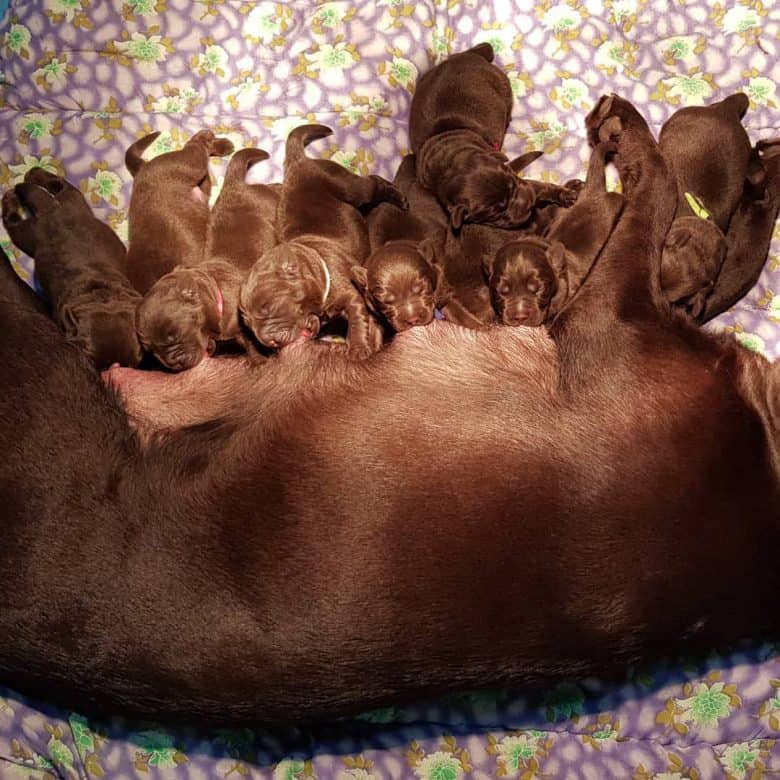
Many breeders and owners look down on those who breed solely for color because the general consensus is that breeders who breed-specific colors are only in it for profit.
Since breeders should focus on health and temperament, color shouldn’t come into play.
However, this has not stopped people from breeding for Chocolate Labs, and it doesn’t mean that they are all bad. You can also find good Chocolate Lab breeders. They often have Black Labs or dilute Browns as well.
You can find good breeders from the AKC marketplace, forums, blogs, even tweets on Twitter or videos on Youtube. Here are a few Chocolate Lab breeders to start you on your search:
- Dry Pond Retrievers (Johnston, SC)
- Hidden Pond Labradors (New York)
Rescue a Chocolate Lab
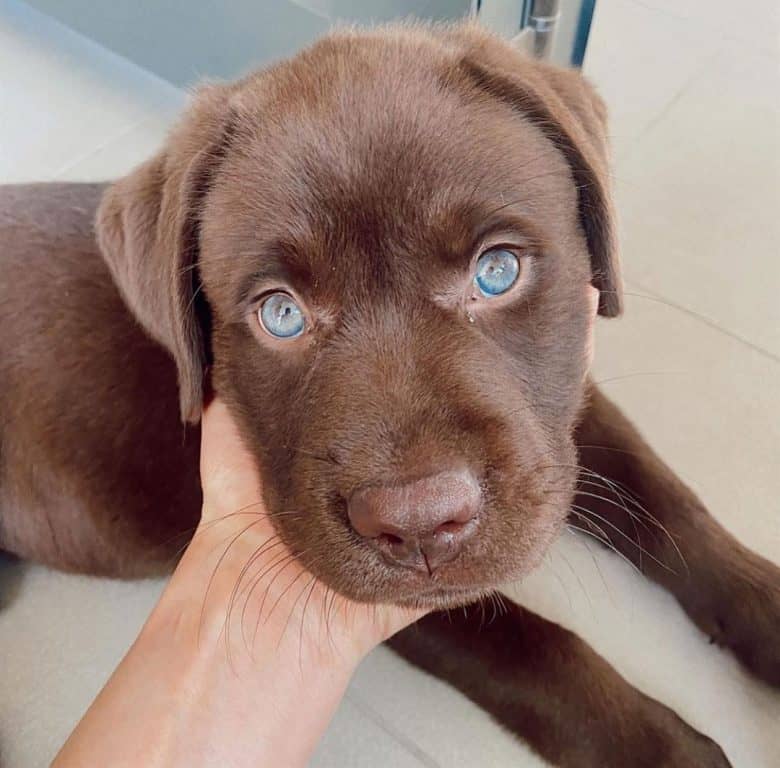
If adopting a dog is more up your alley, good on you! There are so many dogs in shelters that just need a loving family and a good home.
There are Lab rescues all over America dedicated to rehoming these lovely animals.
When rescuing, make sure you understand what is entailed. Sometimes, certain dogs come with health or behavioral issues that might need to work on.
The carers at the shelters should be able to give you a good recommendation based on your personality and lifestyle.
Here are a few Lab rescues that may have a Chocolate Lab waiting for you:
- Lab Rescue LRCP (Annandale, VA)
- Labrador Retriever Rescue of Florida (Pompano Beach, FL)
- Golden Gate Labrador Retriever Rescue (San Francisco Bay Area, CA)
Who Should Get a Chocolate Labrador Dog?

Labradors are pretty much for everyone who is looking for a fun playmate that’s relatively low maintenance. However, these sweet dogs do need a substantial amount of exercise daily.
They aren’t suitable for people who lead sedentary or busy lives because they love being on the go and they love spending time with their humans. It would not do if they were left home alone for extended periods of time.
Reference
Cess is the Head of Content Writing at K9 Web and a passionate dog care expert with over 5 years of experience in the Pet Industry. With a background in animal science, dog training, and behavior consulting, her hands-on experience and extensive knowledge make her a trusted source for dog owners.
When not writing or leading the K9 Web content team, Cess can be found volunteering at local shelters and participating in dog-related events.

We have a 7 yr English chocolate lab male, and a 1 yr old American chocolate pointing lab from South Dakota.
The 7 yr old was rescued at 14 months old, and came with many issues. We’d raised black labs for 16 years and never had problems with them apart from all of them having cancer from age 8 and up. Our rescue boy was extremely challenging but we committed to giving him a forever home and today he’s the BEST house dog you’d ever want. He is very overweight thanks to elbow, shoulder and hip problems. He’s on Novox and Adequan, which help. He’s on a weight control diet, and is slowly losing the extra weight.
He’s absolutely fearless….we live in northwest Virginia in the mountains and have a big variety of wildlife. He’s treed five bears at one time to my horror, he’s very independent minded and listens when he wants to.
The puppy is super energetic, and is on purina pro plan large breed food for slow growth. His breeder says they’ll finish growing around 18-20 months. He’s already 28″ at the shoulder, and is very long…much like a thoroughbred racehorse. My brother has his sister (same litter) and is experiencing the same idiosyncrasies as our pup such as a super fast frantic racing reaction to a scary experience, leaping like a jackrabbit. We try to limit his wild exercise but it’s like trying to rope the wind. He’s been through an obedience course and is much improved over before he went at 6 months. The trainer did say that he was a handful.
Overall, they’re great dogs, but not for everyone. They need a lot of attention and love.